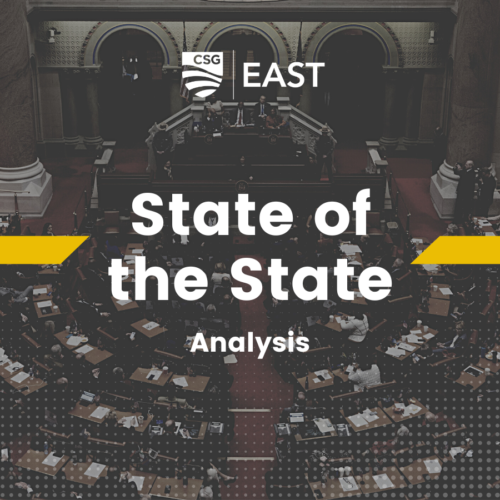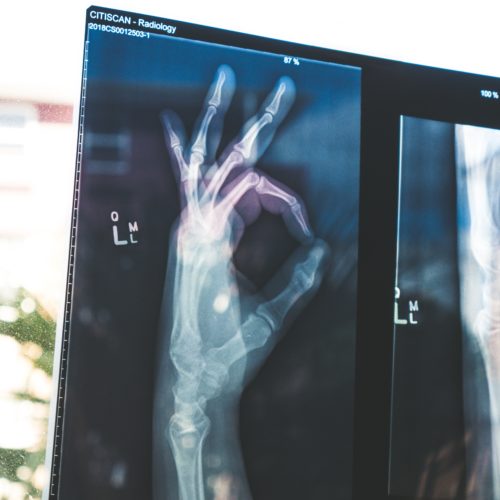State of the State Analysis: Delaware and Connecticut

Delaware
Top Highlights
- Education Investments
- Workforce shortages
- Housing
- Fiscal Responsibility
Governor John Carney, entering his sixth year as governor of the First State, spoke to a packed Senate Chamber on Thursday, laying out his priorities for the year ahead.E
Early in his address, Carney insisted that Delaware’s “success as a state must start with building a strong and growing economy,” citing examples in every corner of the state where new businesses and economic investments were paying dividends for the state’s economy. But, he warned, today’s economy looks very different from the past.
Employers have 37,000 job openings in the State of Delaware. And there are just 21,000 Delawareans looking for a job. I’ve never seen a situation like this before.
“The biggest challenge we have is filling the job openings that are out there,” he said.
“For my entire career in public service, we’ve been focused first on creating jobs. There have always been more people looking for work than jobs available. Today, it’s just the opposite. We have thousands more job openings than we have people looking for work.”
Carney explained that the trend extended to state government, where there are 2,000 job openings currently seeking applicants.
He underscored the importance of the state’s universities, not only in worker training but in competitive employment.
ARPA funding, as in many states, is also driving new opportunities. Carney specifically identified a program using ARPA funding to rehabilitate blighted homes on the east side of Wilmington, the state’s largest city.
But no part of Carney’s speech included more concrete details on new spending than the section on Education.
Right now, the competition for the best teachers in this region is more intense than ever.
Carney, whose parents were both educators, touted major raises for Delaware teachers amid rising competition for educators in the region and outlined a plan to increase investments in Early Childhood Education. Stressing that a strong economy starts with a good education, he promised raises up to 9 percent for Delaware teachers. The Opportunity Funding program – which provides additional funding for low-income children and English learners in Delaware schools – is also slated to receive an additional $50 million. Opportunity Funding grew out of an ACLU lawsuit that previously claimed the state was not upholding its constitutional obligations to all students. Additional details on implementation are available, thanks to a state partnership with RAND.
Carney also pledged to increase funding for early childhood education in Delaware. he singled out the state’s purchase of care program and the Early Childhood Assistance Program (ECAP), the latter of which he said would receive double its current appropriation in his budget.
All of this funding was meant, in one way or another, to achieve Delaware’s education goals, explained by Carney as the expectation that children should be able to:
• Read at grade level by third grade.
• Be proficient in math by middle school.
• Graduate high school ready for college or a career.
We’re the lowest–lying state in the nation. And the effects of climate change and sea level rise on Delaware communities are real.
On the climate, Carney moved on to highlights of his administration’s plans to increase funding for Delaware’s Clean Water Trust, plant a tree for every Delawarean, and build out Delaware’s electric vehicle charging infrastructure.
Carney paused briefly to celebrate progress made on the public safety front, touting a nearly 30 percent reduction in shootings statewide over the previous year. He also pointed to continued work with leaders in Wilmington and Dover to expand Delaware’s Group Violence Intervention Program.
When I took office six years ago, we were facing an almost $400 million deficit. Now, we have $400 million more in reserves for when the economy turns down again which we know will happen at some point.
Finally, Carney promised to prioritize fiscal responsibility, which has been a hallmark of his time as chief executive of Delaware, explaining that “we can’t make any of these investments – in education, in our economy, in environmental protection and public safety – if we don’t have our fiscal house in order.”
You can read the full text from Delaware State of the State address here.
Connecticut
Highlights:
- Fiscal stability
- Job growth via investments in workforce, small businesses
- Housing
- Promised tax cut for middle class families
Connecticut Governor Ned Lamont, newly elected to a second term, gave his state of the state immediately after being inaugurated in Hartford on January 4.
His address was the second earliest of the year, tied with Andy Besear in Kentucky and behind only Doug Burgum in North Dakota, who gave his address on January 3, 2023.
Lamont hailed progress made during his first term in the governor’s mansion – especially on stabilizing the state’s budget – before diving into his vision for continued economic growth.
My fiscal priorities are economic growth, because growth is the precondition to opportunity.
Instead of the shuttered businesses and direct payments that defined the Covid-19 crisis, Connecticut is now facing the tight labor market that so many other states in the region are struggling with. Lamont specifically cited “100,000 jobs going begging” in Connecticut, owing mainly to a reduced workforce, slow population growth, and a skills gap between available workers and open jobs.
To meet those challenges, he highlighted Connecticut laws to:
- Offer paid family medical leave, expanded childcare, and paid sick days.
- Tie minimum wage increases to inflation
- Provide skills training opportunities to workers in the state through their CareerConnCT program.
- Fund small businesses and entrepreneurs through a small business boost fund, especially those led by women and people of color.
Still, larger problems loom on the horizon, according to the governor:
But the biggest slam to our affordability and economic growth is housing, or the lack thereof. Every business thinking about moving or expanding repeats over and over, “Even if you had the workforce, there is no place for them to live.” The answer cannot simply be more subsidies.
Housing – an issue growing increasingly urgent around the region – is complex for state governments to tackle, requiring close cooperation between multiple levels of government. Lamont admitted as much, saying that “The answer cannot simply be more subsidies” and imploring local government to communicate with state leaders.
“Connecticut towns and cities, you tell us where developers can build more housing so more housing can be built faster, at less cost, and local control will determine how and where it is built.”
After many years of unfilled promises, now is the time to enact a meaningful middle-class tax cut. That’s a reduction in tax rates, which the state can afford and makes your life more affordable.
Finally, Lamont argued for a small but “meaningful” tax cut, something he should now be more palatable with a balanced state budget.
“Thanks to our collective efforts, the era of Connecticut’s permanent fiscal crisis is over. It’s over as long as we maintain the same fiscal discipline that served us so well over the last four years,” he added.
The governor has been hinting at this tax cut proposal, according to CT Insider reporting from last December. The governor wanted a modest cut for joint filers earning up to $150,000 in yearly income, who currently pay a 5 percent rate.
“It’s a little premature, but the 5 percent rate, if I can get that down to 4.75 or 4.5 in negotiations with our friends in the legislature, I think it would be a good start,” he was quoted as saying at the time.





